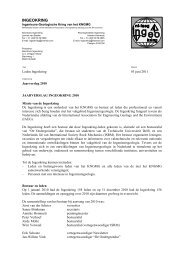News letter Dam edition
News letter Dam edition
News letter Dam edition
- No tags were found...
Create successful ePaper yourself
Turn your PDF publications into a flip-book with our unique Google optimized e-Paper software.
Ingeokring <strong>News</strong><strong>letter</strong><br />
8.2 Effects of dissolution below the canals and the irrigation<br />
area<br />
During the helicopter survey made in June 1986 it was observed<br />
that at many places where gypsum is present near<br />
the earth surface (for example near the camp site), sinkholes<br />
of varying size (0.1-3 m diameter) are present (Photos 5 and<br />
6).<br />
It may be expected that dissolution along the main canal<br />
and primary and secondary canals also could take place<br />
giving rise to leakage and surface subsidence.<br />
The situation below a canal can be analysed as follows<br />
(Figure 14, from James & Lupton (1978)):<br />
dM<br />
- = K dA(Cs<br />
- C)<br />
dt<br />
where M is the amount of gypsum dissolved at time t, A is<br />
the surface area of gypsum in contact with fresh water and C<br />
is the concentration of dissolved gypsum in the water (since<br />
this is constantly refreshed this may be taken as zero).<br />
The linear retreat of the gypsum surface below a canal may<br />
also be written as -dZ/dt (see Figure 14) and the amount of<br />
gypsum dissolved per unit of time:<br />
dM dZ<br />
- = .A.ρ<br />
dt dt<br />
Combining (6) and (7), taking C=0:<br />
dZ K d C s<br />
- =<br />
dt ρ<br />
Again K d and C s have to be estimated and depend on flow<br />
rate, temperature and concentration of sodium chloride in<br />
the groundwater.<br />
Example 1. In the case of a silt layer between massive gypsum<br />
and the canal (Figure 14):<br />
Take K d =10 -4 m/s and a low hydraulic gradient, then v~10 -5<br />
m/s. If the silt contains salts, then the groundwater may<br />
have dissolved sodium chloride (NaCl) in it and estimates of<br />
K d =5x10 -5 m/s and C s =10 kg/m 3 may apply. This gives<br />
(Equation 8):<br />
dZ -4<br />
5 × 10<br />
-<br />
- = = 2.16 × 10<br />
7<br />
dt 2320<br />
(6)<br />
(7)<br />
(8)<br />
= 6.8m / year<br />
Example 2. If no sodium chloride is present, then K d =10 -5 m/s<br />
and C s =2.5 kg/m 3 and<br />
dZ 2.5 × 10<br />
-<br />
- =<br />
= 1.08 × 10<br />
8<br />
dt 2320<br />
Example 3. If free flowing canal water is flowing directly<br />
over a gypsum rock surface, with a velocity of 0.5 m/s, then<br />
at 23 °C: K d =4x10 -5 m/s (James & Lupton, 1978). Since hardly<br />
any sodium chloride is present in Wabi Shebelle water,<br />
C s =2.5 kg/m 3 .<br />
-5<br />
-5<br />
dZ (4 × 10 ).(2.5)<br />
-<br />
- =<br />
= 4.3 × 10<br />
8<br />
dt 2320<br />
These values are high and show that protection against contact<br />
with fresh water is necessary. They also explain why<br />
sinkholes may develop rapidly in the wadis of the irrigation<br />
area during the rainy season, the only time when water is<br />
flowing over these areas. Consider a locality where silt containing<br />
some sodium chloride salts is present above gypsiferous<br />
rock (the conditions of example 1). Say a localised<br />
flow of water during the rainy period occurred for a period<br />
of two weeks, then a retreat of the underlying gypsum surface<br />
of 6.8 m/year x (2/52) = 0.26 m could occur. This is sufficient<br />
for a small sinkhole to develop (Photo 6).<br />
These calculations can be considered as examples. Comparable<br />
calculations for different rock types are shown in Table<br />
1. The calculated solution rates are regularly confirmed by<br />
observations and reported in literature (James et.al., 1981).<br />
Using actual site measurements of flow velocities and electrical<br />
conductivity measurements of the water and groundwater,<br />
these could be tailored to the real situation.<br />
8.3 Design of monitoring program<br />
= 0.34 m / year<br />
= 1.36m / year<br />
Before the actual construction starts, many data can be<br />
gathered and monitored that would aid in the refining of<br />
the prediction of dissolution behaviour of gypsiferous rocks<br />
and soils under hydraulic structures in the irrigation area.<br />
Monitoring of piezometric levels in the piezometric stations<br />
at the dam site, together with temperature and electrical<br />
conductivity measurements will give information on hydraulic<br />
conductivity and also whether there is any fluctuation of<br />
the salinity of the groundwater. Also the variation in C<br />
(solubility) over the site and in the irrigation area can be<br />
obtained this way (by similarly measuring the electrical conductivity<br />
of the groundwater in other boreholes).<br />
During and after construction it is highly advisable to monitor<br />
the groundwater, to be aware of any changes in conditions.<br />
After construction, the groundwater should be con-<br />
<strong>Dam</strong> <strong>edition</strong> | Double Issue 2007/2008 | 36




